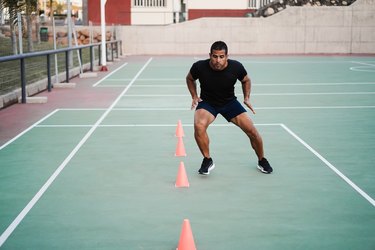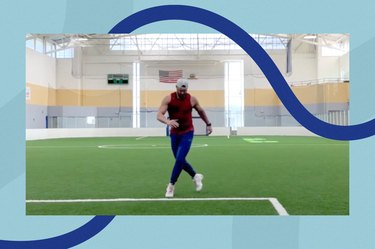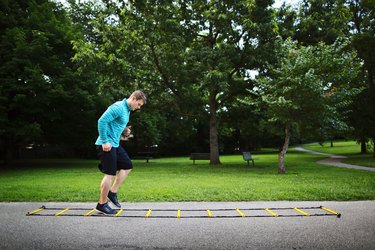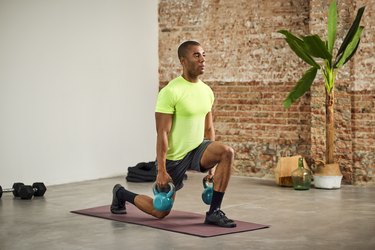
Part of getting ready for the rigors of sports or other physical activity is improving footwork, which affects agility. Agility exercises help you gain better control of your body and movements, honing your ability to change directions quickly and efficiently, without sacrificing speed or balance.
Agility and footwork are key to every major sport, including football, baseball, basketball and soccer. But anyone can improve their quickness, power, balance and coordination by incorporating specific exercises into their workout routine. Below are several examples of agility exercises, and including a few of them in your regular routine can help you reap their benefits.
Video of the Day
Video of the Day
Footwork and Agility Drills for Adults
1. Ladder Drill
One way to boost your agility is with an agility ladder, a lightweight piece of equipment resembling a ladder that you place on the ground to help guide you through footwork drills. You can purchase them as a piece of exercise equipment or create your own with tape or spray paint.
If you make the ladder yourself, space the "rungs" 1 to 2 feet apart so you can easily step in and out of them. In ladder drills, the point is to step inside the ladder, between the rungs, without your feet touching it. Different drills can target different types of footwork, such as moving side to side, forward or backward.
Try a lateral shuffle. This type of movement gets your body moving in a different way (side to side rather than front to back), and the rapid change of direction when you reach the end of the ladder enhances agility, according to the American Council on Exercise.
- Stand sideways in a square at one end of the ladder.
- Get into athletic stance with your feet hip-width apart and knees slightly bent.
- Quickly shuffle along the length of the ladder, moving from square to square.
- Once you reach the end, shuffle back to the start.
Or you can do the in-and-out drill to develop quick footwork.
- Stand facing the ladder, with it lying lengthwise in front of you.
- Starting at one of the ends, put one foot into a section of the ladder, then the other foot
- Quickly remove the first foot, followed by the second one
- Repeat as quickly as possible, shifting down the ladder and repeating for all the separate sections until arriving at the end of the ladder.
- Take a quick rest before doing the same thing back to where you started.
2. Cone Drill
Cones are a versatile piece of equipment that can be set up in a variety of formations for agility exercises. The movements described below all work on your speed, quick stops and rapid directional changes.
- With several cones set up in two rows, run zigzag drills to target agility.
- Position the cones about 2 feet from each other.
- Try a forward zigzag by running in and out in a zigzag pattern along one row of cones.
- Try the same exercise in reverse for a backward zigzag.
- You can also use both rows of cones for a sideways zigzag.
3. Step Drill
Using a step or elevated platform to perform specific drills is another effective way to develop footwork and agility. As with the ladder drills, step drills can be done side-to-side or front-to-back to develop the different footwork skills needed.
- Stand in front of a step or elevated object.
- Step up with one foot, then the other foot.
- Then, step down with the first foot followed by the second foot, as quickly as possible.
Tip
This drill can be performed for a certain amount of time or number of reps and trains the feet to move quickly in a specific direction.
Drills can also be done standing to the side of the step and stepping sideways with one foot, bringing the other foot up, then stepping off to the other side with the first foot, and then with the second foot, ending up on the opposite side from where the participant started.
4. Figure Run
A figure run is an agility drill that improves your footwork and quickness.
- Mark out three figures, such as A, B and C.
- Have a partner time you to see how fast you can finish all three figures.
- Start by running around the first figure, then the second and finally the third.
5. Partner Shuffle
You'll need a workout buddy for this agility exercise, but the benefit is that you won't be able to anticipate which direction you'll be moving or when, which forces you to react more quickly.
- Assume an athletic stance while you wait for your partner to tell you which direction to begin with.
- Once they do, shuffle rapidly that way, listening for your next cue.
- Your partner will continue to calls the shots, telling you which direction to move — left, right, forward or back.
Tip
Try not to cross your feet while you shuffle and respond as quickly as possible to his direction.
6. Accelerating Sprint
To improve your speed, perform accelerating sprints.
- Mark distances of 50 yards and 100 yards.
- Start by gradually accelerating your speed until you reach full speed by the time you reach the 50 yard marker.
- Sprint until the 100 yard marker.
- Walk back to the start and perform the exercise again.
7. Backpedal Sprint
Backpedal sprints should be done by people who already have some agility training, as they require a bit more skill.
- Determine a start and finish line that are several paces apart or set up cones to indicate the lines.
- From the starting line, sprint forward to the finish line.
- Stop abruptly, then backpedal quickly back to the starting line.
Tip
Maintain full speed for the duration of the exercise, with explosive starts and fast stops.
Backpedal sprints can also be made more challenging with a long resistance band, which you can attach to yourself with a belt. Secure the other end to a fixed object to create resistance during the sprint.
8. Jump Rope
Jumping rope can improve your coordination, as you have to time your jumps to coordinate with swinging your arms with the rope. Jump roping is a popular footwork drill used by boxers as a way to train the feet to move quickly in the ring.
- Use a long rope held in both hands.
- Twirled it over your head, then under you feet as you jump over it.
- Drills can be done by varying the speed and height of the jump as well as trying to revolve the rope multiple times in one jump.
- You can also run or walk as you jump rope, as well as moving the feet in different directions, such as side to side or front and back while maneuvering the rope.
9. Squat Jump
To enhance your power, you can perform a squat jump.
- Stand with your feet shoulder-width apart, elbows flexed at 90 degrees.
- Squat down until your thighs are parallel with the ground.
- Jump up with both legs, swinging your arms up overhead.
- Land on both feet and immediately jump back up. Keep ground contact to a minimum.
10. Single-Leg Balance
Balance exercises increase your stability by activating and strengthening muscles to keep you in one position.
- Stand with your hands at your hips on an unstable surface with both feet, such as a balance disc or pillow.
- Lift one foot up, bending at the knee, and hold for 10 seconds.
- Switch sides.
Speed and Agility Training for Kids
Children develop speed and agility at an early age, when they chase their friends or family pet around the yard. But any formal speed and agility training programs should be developed in age-appropriate stages.
The National Strength and Conditioning Association recommends that children between the ages of 5 and 8 be exposed to a variety of movement patterns, which include arm and leg movements performed from a stationary position, jumping moves and exercises that promote spatial awareness.
Skill mastery is enhanced between ages 9 and 13. Exercises that involve running through a maze of cones, moving in figure eight pattern and jumping and landing in a controlled manner are suitable for teenagers age 13 to 16.
Warning
Avoid forcing your child to perform training drills that are inappropriate for their level of development. Doing so may cause permanent injuries or make your child averse to any type of physical activity.
Experiment with different activities. The child who doesn't like to toss a ball may enjoy rhythmic musical activities.
- Soccer Coaching Notes: "Basketball Drills: Improving Footwork"
- Coach's Clipboard: Footwork Drill
- ExRx.net: "Speed, Quickness & Agility Training"
- American Council on Exercise: "Agility Ladder: Lateral Shuffle"
- Brian Mac Sports Coach: "Agility Training to Meet the Demands of Field and Court Games"
- Collegium Anthropoligicum: "The impact of football training on motor development in male children"
- National Strength and Conditioning Association: "BASICS OF STRENGTH AND CONDITIONING MANUAL"


